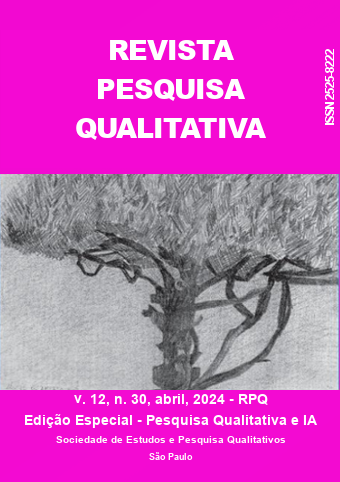GenIA platform: a proposal for using artificial intelligence and intuitive programming in the creation of learning objects
DOI:
https://doi.org/10.33361/RPQ.2024.v.12.n.30.720Keywords:
Mathematics Education, Artificial intelligence, Learning objects, GenIA platform, Intuitive programmingAbstract
In Education, the use of artificial intelligence is observed, albeit timidly, in various situations ranging from management support to contributions to teaching and learning processes. This article presents completed doctoral research that investigated how artificial intelligence resources, combined with intuitive programming, could be explored in creating a platform for building Mathematics learning objects. Methodologically, prototyping and educational design research were employed. As part of a professional doctoral program, the research yielded an educational product called GenIA, which relies on the pillars of intuitive programming to construct Mathematics learning objects using flowcharts, assisted by artificial intelligence algorithms and machine learning. The platform was validated in different contexts and demonstrated its viability for use in Mathematics classes.
Downloads
References
BALBINO, R. O.; KALINKE, M. A.; ZATTI, E. A.; MATTOS, S. G. DE; LOSS, T.; MOTTA, M. S. Programação Intuitiva: em Busca de Compreensões. Perspectivas da Educação Matemática, Campo Grande, v. 14, n. 36, p. 1-22, dez. 2021. https://doi.org/10.46312/pem.v14i36.12121. DOI: https://doi.org/10.46312/pem.v14i36.12121
BALBINO, R. O.; MATTOS, S. G. Uma proposta de utilização da MPEDUC para a construção de objetos de aprendizagem. In: MOTTA, M. S.; KALINKE, M. A. (org.). Inovações e Tecnologias Digitais na Educação: uma busca por definições e compreensões. Campo Grande, MS: Life Editora, 2021, p. 57-74.
BICUDO, M. A.; COSTA, A. P. (org.). Leituras em Pesquisa Qualitativa. São Paulo: Editora Livraria da Física, 2019.
BORBA, M. C.; SCUCUGLIA, R. R. S.; GADANIDIS, G. Fases das tecnologias digitais em Educação Matemática: sala de aula e internet em movimento. 2. ed.; 2. reimp. Belo Horizonte: Autêntica, 2018.
D’AMBROSIO, U. In: ARAÚJO, J. L., BORBA, M. C. Pesquisa Qualitativa em Educação Matemática. Belo Horizonte: Editora Autêntica, 2004. p. 9-21.
GATES, B. The Road Ahead. New York: Viking Penguin, 1995.
HAYKIN, S. Redes Neurais - Princípios e Práticas. 2. ed. São Paulo: Bookman, 2001.
KALINKE, M. A.; BALBINO, R. O. Lousas Digitais e Objetos de Aprendizagem. In: KALINKE, M. A.; MOCROSKY, L. F. (org.). A Lousa Digital & Outras Tecnologias na Educação Matemática. Curitiba, CRV, 2016. p. 13-32.
KUBAT, M. An Introduction to Machine Learning. 2 ed. Cham: Springer, 2017. DOI: https://doi.org/10.1007/978-3-319-63913-0
LÉVY, P. A ideografia dinâmica: Rumo a uma imaginação artificial? 2. ed. São Paulo: Edições Loyola, 2004.
LÉVY, P. A inteligência coletiva: por uma antropologia do ciberespaço. Tradução de Luiz Paulo Rouanet. 5. ed. São Paulo: Edições Loyola, 2007.
LÉVY, P. O big data e a próxima revolução científica. 2016. Disponível em: https://www.youtube.com/watch?v=W5hIcxKPVRw. Acesso em: 24 set. 2023.
MCCARTHY, MCCARTHY, J.; MINSKY, M. L.; ROCHESTER, N.; SHANNON, C. E. A Proposal for The Dartmouth Summer Research Project on Artificial Intelligence. 1955. Disponível em: http://www-formal.stanford.edu/jmc/history/dartmouth/dartmouth.html. Acesso em: 24 set. 2023.
MCCULLOCH, W. S.; PITTS, W. H. A Logical Calculus of The Ideas Immanent. Nervous Activity. Bulletin of Mathematical Biophysics, New York, v. 5, n. 01, p. 115-133, 1943. DOI: https://doi.org/10.1007/BF02478259
MEIRELES, T. F. Desenvolvimento de um Objeto de Aprendizagem de Matemática usando o Scratch: da elaboração à construção. Curitiba, 2017. 217 f. Dissertação (Mestrado em Educação) – Universidade Federal do Paraná, Curitiba, 2017. Disponível em: https://acervodigital.ufpr.br/xmlui/handle/1884/56109. Acesso em: 20 mar. 2024.
MINSKY, M. L.; PAPERT, S. A. Perceptrons: An Introduction to Computational Geometry. Expanded Edition. 3 ed. Boston: MIT Press, 1988.
ML.NET. What is ML.NET? Disponível em: https://dotnet.microsoft.com/en-us/learn/ml-dotnet/what-is-mldotnet. Acesso em: 24 set. 2023.
MOTTA, M. S.; KALINKE, M. A. Uma proposta metodológica para a produção de objetos de aprendizagem na perspectiva da dimensão educacional. In: MOTTA, M. S.; KALINKE, M. A. (org.). Objetos de aprendizagem: pesquisas e possibilidades na Educação Matemática. Campo Grande, MS: Life Editora, 2019, p. 203-218.
MOTTA, M. S.; KALINKE, M. A.; MOCROSKY, L. F. Mapeamento das dissertações que versam sobre o uso de tecnologias educacionais no ensino de Física. Actio: Docência em Ciências, Curitiba, v. 3, n. 3, p. 65-85, set./dez. 2018. http://dx.doi.org/10.3895/actio.v3n3.7591. DOI: https://doi.org/10.3895/actio.v3n3.7591
PLOMP, T. Educational design research: an introduction. In: PLOMP, T., NIEVEEN, N. (org.). Educational design research – Part A: an introduction. 3 ed. Enschede: Netherlands Institute for Curriculum Development (SLO), 2013. p. 10-51.
PRESSMAN, R. W; MAXIM B. R. Software Engineering – A Practitioner's Approach. 8th ed. New York: McGraw-Hill, 2015.
RUSSELL, S. Inteligência artificial a nosso favor: Como manter o controle sobre a tecnologia. Tradução de Berilo Vargas. São Paulo: Companhia das Letras, 2021.
SCRATCH. Crie estórias, jogos e animações. Disponível em: https://scratch.mit.edu/. Acesso em: 24 set. 2023.
SEARLE, J. Minds, brains, and programs. The Behavioral and Brain Sciences, Berkeley, v. 3, p. 417-457. 1980. Disponível em: http://cogprints.org/7150/1/10.1.1.83.5248.pdf. Acesso em: 24 set. 2023.
SOMMERVILLE, I. Software Engineering. 10th ed. Harlow: Pearson Education Limited, 2016.
STAVNY, F. M.; MATTOS, S. G.; BALBINO, R.; ZATTI, E. A.; KALINKE. M. A. Em busca de compreensões sobre utilização de recursos digitais na criação de objetos de aprendizagem de matemática. REVEMAT: Revista Eletrônica de Educação Matemática, Florianópolis, v. 16, p. 01-22, jan./dez. 2021. https://doi.org/10.5007/1981-1322.2021.e80312. DOI: https://doi.org/10.5007/1981-1322.2021.e80312
TIKHOMIROV, O. K. The Psychological Consequences of Computerization. In: WERTSCH, J. V. (org.). The Concept of Activity in Soviet Psychology. New York: M. E. Sharpe Inc., 1981. p. 256-278.
TIOBE. TIOBE Programming Community Index. 2023. Disponível em: https://www.tiobe.com/tiobe-index/. Acesso em: 24 set. 2023.
TOFFLER, A. A Terceira Onda. Rio de Janeiro: Record, 1980.
ZATTI, E. A. Programação orientada a objetos. Curitiba: Fael, 2017.
ZATTI, E. A.; KALINKE, M. A. Inteligência Artificial na Educação Matemática: tendências ou “entendências”. In: KALINKE, M. A.; MOTTA, M. S. (org.). Inovações e Tecnologias Digitais na Educação: uma busca por definições e compreensões. Campo Grande, MS: Life Editora, 2021. p. 75-96.
Downloads
Published
How to Cite
Issue
Section
License
Copyright (c) 2024 Qualitative Research Journal

This work is licensed under a Creative Commons Attribution 4.0 International License.
Essa revista é licenciada pelo sistema creative commons 4.0, não-comercial.
















